 |
Art & Architecture
Modern Art, Socialism & Marxism
Cunha Alvarenga
Expositions of modern art can easily produce the impression that most of the works are expressions of the extravagance, madness, stupidity or shrewdness of “artists” who want to exploit the naïve public and sell their paintings for disproportionate prices. Distorted features, inconsistent lines and ill-assorted forms – almost everything expresses ugliness, the grotesque, the unbalanced, the monstrous or despair.
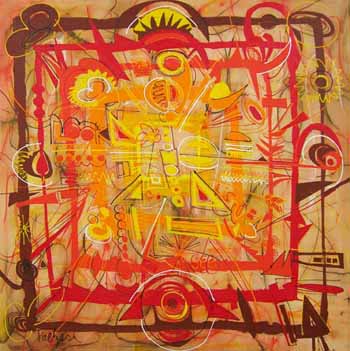
Is modern art a coincidence or does it have an agenda? |
A critic cannot help but think that this chaotic art was not created randomly. Hence the question emerges: Are these deformations made on purpose to corrupt the aesthetic sense of society by brutalizing the sentiments and perverting tastes?
A more demanding observer could go further and ask whether there is something else hidden behind this general madness. Just as hermeticism and the kabala are behind some forms of poetry, perhaps modern art is leading us to something new being prepared for society in the future.
Abstract Art & Socialism
This question is answered in part by looking at some revolutionary political currents that converge with modern art. Commenting on the First Biennale of Modern Art that took place in São Paulo in 1951, art critic Lins do Rego stressed the political character of the new art:
“What we are seeing is more a political battle than a polemic over art. There are those who want to use painting to further their political agenda, and they entered this dispute between figurativists and abstractionists as a pretext. They are not interested in color, form, design and sculpture; what they want is to impose principles that are less related to the technique of painting than to a method of stirring up the masses. Their models are not Da Vinci and other art masters, but rather Engels, Marx and others much closer to us. This is the key to understand this discussion that is sterile about art, but fecund regarding social revolution.” (1)
Mr. Lins do Rego’s critique is good in that it shows that modern art is being used by agitators to foster the Communist-Socialist agenda, but it does not explain everything. It implies that if it was not being used for political purposes, authentic modern art would be good. Is this correct?
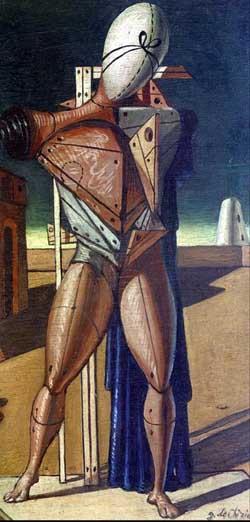
The Seeker by Fascist artist De Chirico, a critique of modern man and society |
An answer to this question appears in the apologia of the Second Biennale of Modern Art in São Paulo (1953) by Mr. Murillo Mendes, a defender of abstract art. He affirms:
“We need to realize that what is called abstract art is a consequence of a vast movement not only in aesthetics but also in politics, philosophy and morals. It wants to reform a world where these values are intertwined.
“We dream of a new ordering of values where content and form will balance each other, where the higher realm of the spirit will resonate in the social and economic structures of society. From this perspective, one can readily see that abstract art is not opposed to reality, but an amplification of it. Today’s abstract artists are merging with the great political utopians and scientists of the past to achieve their mutual ideals. (2)
Mendes clearly states that the purposes of abstract art merge with the aims of utopian politicians and philosophers. What aims are these, if not the advent of Socialism in the world?
Sir Herbert Read, English anarchist, poet and adept of abstract art, goes further and clearly identifies abstract art’s ideals with those of Socialism. He states:
“Abstract art is the art of the future, the art of a classless society. It is impossible to predict all the forms this art will have. It will take many years for it to fully mature. We must literally construct a new society with bricks and cement, steel and glass, and we cannot build this society without artists.
“The artists are there waiting for an opportunity: abstract artists who are now in a transition phase, improving their sensibility. When the moment comes, they will be ready to apply their talents to the great work of reconstruction. This reconstruction will not be made to please romantic traditionalists or literary sentimentalists. The construct of Socialism is realist, scientific and essentially classic.” (3)
Surrealism & Marxism
It is not only abstract artists who support the egalitarian revolution; before them it was sustained by many figurativists, a type of modern artist that still maintains a strong reference to the real world. The Revolution has many fronts, and we can say that a current of modern art corresponds to each one.
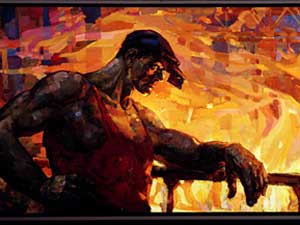
A work by Russian artist Neyasov from the Socialist Realism school |
Let us take, for example, the case of the Surrealists. The Surrealists “evolved” to become Marxists. Some of them, such as the French poet André Breton, followed the Trotskyite line; others, like writer Louis Aragon, preferred the Stalinist line. What is important to note is that all these schools serve the Socialist Revolution. This is true even in the case of Fascists like the Italian poet Marinetti, who politically aligned himself to Mussolini, and the artist Chirico, who stylized the Fascist black-shirts on canvas.
The Surrealists also long for a classless society. French writer Yves Duplessis sets out their goal:
“They do not want surreality to be a chimera accessible only to a privileged few. They are trying to liberate it from the yoke of the Capitalist structure by applying the theories of Karl Marx. In 1929 the Second Manifesto of Surrealism appeared with a clear political character. …
“In 1930 the French magazine The Surrealist Revolution changed its name to become Surrealism at the Service of the Revolution. The change in title corresponds to the movement’s ‘evolution’ from anarchical individualism to their later Socialism. Since the liberation of man is the first condition for the liberation of the mind, they realized that this can be achieved through the proletarian Revolution.” (4)
Concrete art & Socialism
The gurus of modern art do not agree on what will be the art of the future. We can find those who have broken away from Abstract Art in this panorama.
For example Dr. Romero Brest, an influential art critic in Uruguay who was director of its National Museum of Fine Arts, believed that the future belonged not to Abstract Art, but to Concrete Art, a form of abstractionism that wants to express reality in itself . It affirms that lines and colors are concrete by themselves; hence the name of this school. Brest argues:
“The followers of abstract art are those whose creative works are more closely connected to the chaotic aspect of modern reality. Abstractionism is the present. Concrete Art is a prophecy for the future. The followers of Concrete Art try to draw from reality the ideas and forms that allow them to announce a new vision of the world.
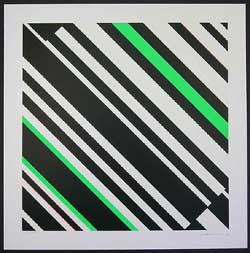
Concrete art reduces reality to form and color - a work by Günter Fruhtrunk |
“Someone might ask us: Why are there so few who are aware of this art since it proceeds from reality? It is because their creations are not based on the superficialities of life, but on principles that, although still expressed by outdated methods, are strong enough, we believe, to transform the very foundations of the behavior of man in the future. This reality, however, is only beginning to emerge. Its construction is composed of symbols and its attitude is essentially prophetic.
“The followers of Concrete Art are a step ahead of reality, which is normal in epochs of initiation. This explains their hesitations and contradictions. It also demands from the spectator a similar faith in the destiny that can only be glimpsed.
“Concrete Art coincides with Neo-Realism, also called Socialist Realism because it orders the rich subjective content of reality in new objective forms.” (5)
Thus we find differences of opinion regarding the art forms that will prevail in the future, but all the currents agree that, with respect to their socio-political character and consequences, the future belongs to Socialism.
Art and literature at the service of the Revolution
The close relationship of Modern Art with the Socialist Revolution is not surprising. If literature and art have always played a salient role in past epochs, why should they not continue to do so in this final phase of the Revolution?
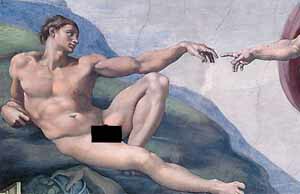
Renaissance art emphasized man's nudity - Adam in the Sistine Chapel |
During the Renaissance, the Humanist literature and art devastated Christendom. It was in the aesthetic and intellectual order that God was first denied, the spiritual needs of the soul abandoned, and everything centered on man, principally his body. No more God, but only man. No more faith, but only reason. No more soul, but only the body.
This complete revolution in the tendencies of the medieval man paved the way for the revolution in the ideas. Humanism and the Renaissance prepared for the Protestant Revolution in the religious sphere with its enormous socio-political consequences. Thus art and philosophy are normally connected to their political-social conquests.
Analogously, if we carefully analyze these aesthetic movements we will find that they largely fostered the revolutionary advance. Victor Hugo, for example, used to say, “Romanticism is Liberalism in literature.” He knew full well what he was talking about, since he was one of the stars of Romanticism.
The correct way to understand art is to look for its connections with the socio-political movements of the times and see how they serve the advance of the Revolution. Doing this, we can understand the great malice of the varied currents
1. José Lins do Rego, "A Semana Traída," Diário de São Paulo, April 22, 1952
2. Murilo Mendes, Sugestoes da Bienal, December 2, 1951
3. Herbert Read, The Politics of the Unpolitical, pp. 130-131.
4. Yves Duplessis, Le Surréalism, p. 111
5. J. Romero Brest, interview in Folha da Manhã, São Paulo, December 14, 1952.

Published in Catolicismo n. 35, November, 1953
Translated and adapted by TIA desk
Posted July 22, 2011

Related Topics of Interest
 Esoteric Characteristics of Modern Art Esoteric Characteristics of Modern Art
 Abstract Art & Theosophy Abstract Art & Theosophy
 Tepee Churches Tepee Churches
 Blasphemy in the Spring 2007 Fashion Collection Blasphemy in the Spring 2007 Fashion Collection
 Trash Art at St. Mary Magdalene Church Trash Art at St. Mary Magdalene Church
 The Taste for the Macabre in Today's Art The Taste for the Macabre in Today's Art
 The Subtle Invasion of Satanism The Subtle Invasion of Satanism
 Requiem for Judas Iscariot Requiem for Judas Iscariot

Related Works of Interest
|
|
Art & Architecture | Hot Topics | Home | Books | CDs | Search | Contact Us | Donate

© 2002-
Tradition in Action, Inc. All Rights Reserved
|
 |

|